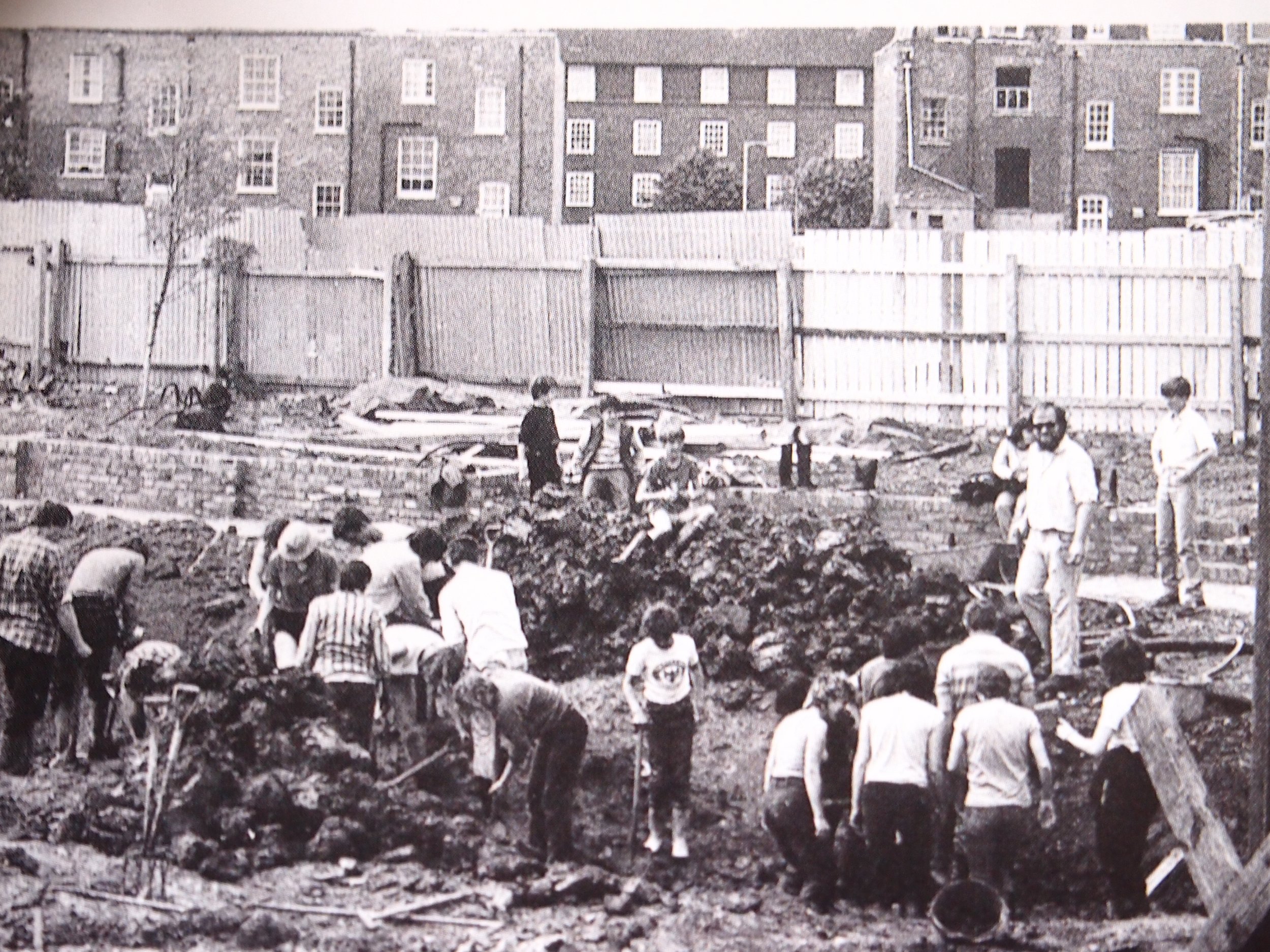Our History
The garden’s origins
The idea of creating the garden came to a school-teacher, Anthea Douglas, when she was cycling to work. It was chance that curiosity got the better of her that day. On impulse she stopped and took a peek through a hole in the high wall. What met her eyes was a bomb-site.
“It was derelict”, she says, “but I saw immediately this deserted place could become a garden for the school children and the local community. She discovered the street (now long gone) was named after Nicholas Culpeper, the great seventeenth century English herbalist whose printing press was in nearby Clerkenwell. It seemed meant to be”.
At the time Anthea was working at the White Lion Free School, near the Angel, an area notorious for dense building and traffic, with little green space. The idea of making a garden caught the imagination of her colleagues. Nearby Penton Primary School joined the scheme, and the two schools pulled together to raise money from a local improvement fund. With that in hand they persuaded the Council to rent the site to them. At first this was only on a temporary basis as the area had been ear-marked for a GP surgery.
Anthea insisted that Culpeper principles should follow the ethos of the White Lion School, namely a place without hierarchy, where everyone’s skills are valid, where all members are involved in making decisions, and no one feels threatened. While Culpeper has changed over the years this early ethos (with adherence to organic principles) is still practised. Friendliness, tolerance, and a relaxed atmosphere are still the garden’s greatest strengths.
Another of the founders, architect Peter Sutton, drew up a plan free of charge in conjunction with landscape architect Kay Mitchell. Anthea recalls that “with the site agreed, some cash in the bank, and a professional plan, the Council finally realised we were serious. They then came up with a grant for the capital works”. They also paid a salary for fellow teacher, Roz Dunwell, who left the school and became the first “garden-worker”.
She was to be the mover and shaker who got the garden built and established. She had contacts with the building trade and managed to get a supply of free bricks, and the use of earth-moving equipment. A partnership was established with Community Service Volunteers (CSV) who were running ‘Operation Clean-Up’ in Islington at the time. Unemployed CSV trainees, under their supervisor, who heroically used an upturned water tank as his office, substantially completed the structural works. They built walls, levelled the land, put up fences and laid pipes. All this was achieved in eight months.
A new chapter for the garden
In 1996 the Council withdrew its small but crucial grant. An immediate outcry ensued from garden members and the public. One councillor was heard to mutter that he had never received so many letters on a single issue before. A protest march to the Town Hall was followed by an impassioned speech by the then Chairman, Ken Standing. At the last minute, when it seemed all was lost, the reprieve came. The Council grant was halved rather than axed.
The Council continued to help in several ways, rebuilding the wall and supplying fences, though their grant dwindled each year and ceased 2002, lapsing until the funding relationship was rekindled in 2020 through Islington VCS funding. While the council’s support is critical to our success, it satisfies a minority of our funding requirements. As a result Culpeper has often struggled to make ends meet. Subscriptions are kept deliberately low, and we have to engage in extensive fund-raising. Culpeper has benefited from many generous funders with particularly strong links to the Cripplegate Foundation, the City Bridge Trust, the Cloudesley Foundation, Trust for London, Hobson Charity, the Shanley Foundation and the Newby Trust.
In 2000 it was decided to raise money to build a Resource Centre that could better cater for the many demands laid upon the garden. Many thanks are owed to Kate Bowen, the Garden Worker at the time, who led the project. Two years later the new building was finished, with a green roof, an office, a tool shed, and a kitchen.
In 2009 Culpeper was one of the first organisations to gain the PQASSO mark (Practical Quality Assurance System for Small Organisations), awarded for good practice in management and business.
In 2012 Culpeper, then a venerable 30 years old and one of the oldest community gardens in London, became a ‘Heritage Site’. We have been honoured with many awards: Islington in Bloom Gold and Silver, and Green Pennant awards which are only given to green spaces run by voluntary community groups. The RHS “It’s your Neighbourhood” scheme has recognised Culpeper as ‘outstanding’. In 2014 the garden was registered as a ‘Fields-in-Trust’, thus protecting it ‘in perpetuity’ as an open space.
As a registered charity Culpeper works hard to bring in the outside community. Events include the Pensioners’ Strawberry Tea, accompanied by live Music Hall favourites with the Pearly Queen in attendance, and Halloween parties when local children tear around the garden as ghouls and witches. Other regular events are the Summer and Winter Solstice parties, Summer Arts weeks for children, practical workshops, and Garden Open Day which coincides with the Open Squares weekend. We organise visits to famous gardens (notably Kew), make-and-take craft workshops, a flourishing choir and other musical events, with projects supporting environmental education.
“Looking back”, reflects Anthea Douglas, the teacher who set this tale in motion, “it has all turned out extremely well. In the end,” she says, “the Council didn’t build a car-park or health centre on the site, but they did build flats on one side and a playground on another, putting the garden at the very heart of the plan”.




